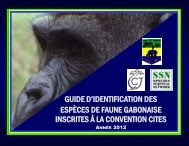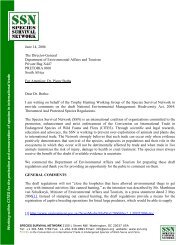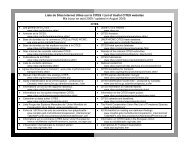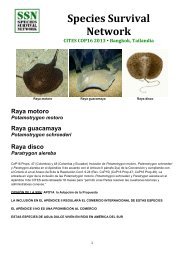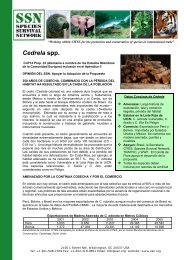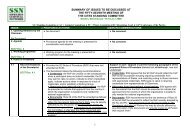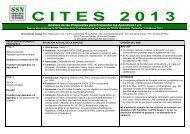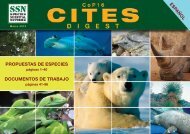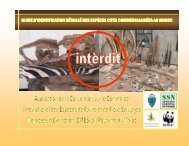CITES CoP16 Digest - Species Survival Network
CITES CoP16 Digest - Species Survival Network
CITES CoP16 Digest - Species Survival Network
You also want an ePaper? Increase the reach of your titles
YUMPU automatically turns print PDFs into web optimized ePapers that Google loves.
SPECIES/PROPONENT/PROPOSAL CURRENT STATUS OF SPECIES SSN VIEW<br />
Prop. 61<br />
Black rosewood<br />
Dalbergia retusa<br />
Granadillo rosewood<br />
Dalbergia granadillo<br />
Belize<br />
Inclusion in Appendix II<br />
Prop. 62<br />
Honduras rosewood<br />
Dalbergia stevensonii<br />
• Distribution: Dalbergia retusa: Mexico to Panama, primarily in dry tropical<br />
forest; distribution highly fragmented. D. granadillo: El Salvador, Mexico.<br />
• Population: D. retusa, Vulnerable (IUCN 1998); populations in some areas<br />
now nearly completely exhausted; Endangered, Panama; Vulnerable, El<br />
Salvador and Honduras; Threatened, Guatemala; Threatened, Costa Rica,<br />
with high risk of becoming Endangered due to significant decline in populations<br />
and habitat; D. retusa may be commercially extinct in some areas.<br />
• Threats: Commercial over-exploitation and habitat loss; extensively harvested<br />
for beautiful, dense, and durable wood used for carvings; removal of<br />
reproducing individuals results in corresponding reduction in population size<br />
and density; habitat under threat from conversion to agricultural use; overall<br />
deforestation in range States between 1990 and 2000 varied from 7,000 ha<br />
in El Salvador to 631,000 ha in Mexico.<br />
• Trade: Both spp. often traded as ‘cocobolo’; mainly sawn wood and manufactured<br />
items; only small quantities of timber reach world markets, at high<br />
prices; cocobolo now rare, mainly harvested from private farms; destructive<br />
harvest from the wild continues; increase in imports by China where it is<br />
generally referred to as ‘redwood’, especially in 2011 and 2012, has raised<br />
serious concerns within the region; reported Chinese imports much higher<br />
than reported exports from range States. e.g. from February-July 2012 Belize<br />
reported exporting 1,377.87 m3 but China reported importing 3,400 m3 from<br />
Belize; Guatemala and Panama populations of Dalbergia retusa on Appendix III.<br />
• Distribution: Belize, Guatemala, Mexico; broadleaf evergreen swamp forests.<br />
• Population: Not assessed by IUCN; small area of distribution; considered<br />
rare; all populations believed to be declining.<br />
• Threats: Illegal and legal logging including for international trade, genetic<br />
erosion, habitat loss, cattle ranching, slash-and-burn agriculture.<br />
• Trade: Highly sought, particularly as a tonewood for musical instruments,<br />
and increasingly by Asian market for furniture and cabinet-making; timber<br />
sourced from wild populations; restricted distribution limits availability;<br />
wastage as high as 80%, as only logs with straightest grain used; trade<br />
increased exponentially in last few years to satisfy demand from Asian markets,<br />
especially China; Guatemala exported 411.009 m3 (2008-2010) and<br />
Belize 25,704.55 m3 from 1999 to January 2012 (<strong>CITES</strong> Trade Database).<br />
SUPPORT<br />
• Extensive and unsustainable harvest has significantly reduced range<br />
and abundance of D. retusa, leading to local commercial extinction.<br />
• Harvest targets mature trees and, combined with D. retusa’s slow<br />
growth rate, leaves not enough trees to produce seedlings, leading to<br />
population declines<br />
• International trade of sawn timber and finished products continues to<br />
pose a threat to both species.<br />
• Illegal logging increasing.<br />
• Imports to China increasing.<br />
• D. granadillo wood indistinguishable from that of D. retusa necessitating<br />
listing of both species.<br />
• Appendix III listings insufficient to control legal and illegal trade.<br />
• D. retusa meets criteria for Appendix II (RC 9.24 (Rev. CoP15),<br />
Annex 2 a), B)): internationally traded • wild populations declining<br />
• slow-growing • habitat degradation and loss. D. granadillo<br />
satisfies Criterion A in Annex 2b) of RC 9.24 (Rev. CoP15) for lookalike<br />
reasons<br />
SUPPORT<br />
• <strong>Species</strong> not protected under international legal instruments; no international<br />
measures in place to control movement across international borders.<br />
• Legal and illegal trade including imports to China increased dramatically<br />
in 2011 and 2012.<br />
• <strong>Species</strong>’ habitat in Chiapas, Mexico, is experiencing one of the highest<br />
deforestation rates in the world; Belize currently has highest population<br />
growth rate in Central America which is threatening species’ habitat.<br />
• There is illegal logging and cross-border smuggling of this species in<br />
Belize, Mexico and Guatemala.<br />
• Appendix II will assist range countries to protect the species by regulating<br />
trade and preventing unsustainable harvest.<br />
Belize<br />
Inclusion in Appendix II<br />
www.ssn.org<br />
• Meets criteria for Appendix II (RC 9.24 (Rev. CoP15), Annex 2a),<br />
B)): internationally traded • all wild populations are declining<br />
• high demand and limited availability • international trade is<br />
having a detrimental impact on wild populations<br />
33



